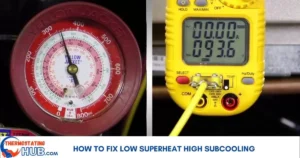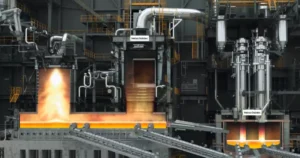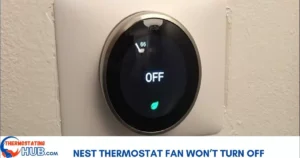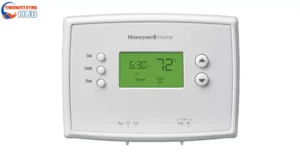Experiencing a furnace that’s humming away but not pushing out any air? Well, you’re in the right place for some guidance.
If your furnace is chugging along but needs to do the crucial job of blowing air, a potential culprit might be a misbehaving blower motor or a problematic blower wheel.
Other factors to consider include broken ductwork, air filters that are clogged to the extreme, or vents that are either closed or blocked.
Now, let’s dive a bit deeper into the possible reasons behind a furnace not blowing air. It’s like having a car engine revving but the wheels refusing to spin—frustrating, right?
The blower motor, akin to an engine, and the blower wheel, like the wheels, need to work harmoniously. Picture it this way, a broken link in this air-pushing duo can result in a toasty furnace but a chilly home. It’s essential to troubleshoot these components to get the warm breeze flowing again.
Possible reasons you have a Furnace running but not blowing air

| Possible Cause | Fix |
| Bad Blower wheel/motor capacitor | Clean/repair or replace wheel or capacitor |
| Excessively clogged air filter | Replace air filter |
| Broken ductwork | Seal off leaks, fix ductwork |
| Closed vents | Open vents, unlock vents, and registers |
Understanding the reasons behind a furnace running without blowing air is the first step, but knowing how to address each issue is crucial. If your blower wheel or motor capacitor is acting up, give them a good cleaning or consider a replacement.
A clogged air filter? Swap it out for a fresh one. For broken ductwork, get handy with some sealing and fixing. Closed vents? Simply open them up, ensuring a clear path for that cozy warmth to reach every corner of your space. Taking these steps will have your furnace back in action, blowing warmth like a champ.
Bad blower heel or motor
Among the most common reasons your furnace is refusing to blow air is the presence of faulty blowers.
The blower assembly is a team player, featuring components like the blower wheel, belt, motor, and capacitor. If any of these elements decide to go on strike, it’ll disrupt the whole air-moving symphony.
Now, let’s troubleshoot. Crack open that furnace and give the blower motor a once-over. Check if it’s doing its spinning dance when there’s a call for heat. Remember to keep the power flowing by pressing the door switch while you’re at it.
Observe and follow these steps:
If the blower is playing the still game, you might have a frozen motor. Switch off the furnace and give it a manual spin.
If the blower wheel is twirling freely, your suspect is the bad capacitor, and it’s time for a bad capacitor replacement.
In either scenario, roll up your sleeves because you’re in for a part replacement. 🔧
Understanding the dance of the blower assembly is like being backstage at a concert – each component has its role, and when one goes off-script, the show can’t go on. A frozen motor or a bad capacitor might be stealing the spotlight, but a hands-on approach, turning off the furnace and replacing the culprit, will have your furnace back on stage, blowing warm air like a seasoned performer.
Excessively clogged Air Filters
Another possible culprit behind your silent furnace is those air filters getting excessively clogged.
When these filters are playing host to a gathering of dust and debris, the blower finds it challenging to usher air into the heat exchangers. The result? Your furnace faces a challenge in spreading that warmth all around your living space.
To check the cleanliness status of your air filters, make your way to the furnace and pop open the blower compartment. Once there, lay eyes on the filters and assess their condition. If they’re looking like they’ve seen better days, it’s time to swap them out pronto.
Remember, it’s not a one-time affair. Make it a habit to replace your filters every 2-3 months. And if you’ve got furry friends sharing your space, consider even more frequent replacements—perhaps monthly. This routine ensures your furnace stays in tip-top shape, always ready to pump out that comforting warmth. 🔄
Think of your air filters as the bouncers at a club – when they’re overwhelmed by the crowd (dust and debris, in this case), it’s tough for the blower to escort the warm air to the party inside your home. Regularly changing these filters is like giving your furnace a VIP pass, ensuring it continues to be the life of the warmth-spreading party in your living space.
Broken duct work
Yet another sneaky suspect behind a running furnace that’s playing the silent game might be those pesky broken air ducts. These ducts play a crucial role as the highways for the heated or cooled air from your trusty HVAC system.
Now, imagine if these ducts decide to throw a party with openings and dislocations – the air takes a detour, escaping through these gaps and missing its cue to spread warmth where it’s needed.
To tackle this issue, start your detective work by inspecting the ductwork. Look out for any openings or air leaks. If your search reveals these gaps, whip out the duct tape and get to work sealing them off.
But hey, if the thought of DIY duct tape action leaves you feeling a bit shaky, it’s totally cool. Consider bringing in the HVAC professionals for some expert assistance.
Broken ducts can turn your HVAC system into a rebellious road trip planner, sending warm air off-course. It’s like having a GPS with a mind of its own. Luckily, a little duct tape magic can get things back on track. If the DIY detective work feels too adventurous, don’t hesitate to call in the HVAC professionals for a seamless fix. More……
Closed vents
Assuming you’ve tackled the blower wheel, ductwork, and air filter hurdles, but your furnace is still in silent mode, it’s time to play detective with your air vents and registers.
Take a stroll around your home and inspect those vents. Confirm that they’re doing their job by staying wide open, ensuring a smooth passage for the air to flow freely. It’s a simple but crucial check.
But hold on, it’s not just about being open; make sure they’re not hosting any unwanted guests like furniture, rugs, or furnace cabinets. These sneaky blockers can put a damper on the free flow of air, disrupting your warm air distribution.
Once you’ve cleared the path, give your furnace another shot at the limelight. Call for heat and see if those vents are now playing their part in spreading warmth around your cozy abode. 🚪
It’s like ensuring the red carpet is rolled out for your furnace – open vents and unobstructed registers make for a grand entrance of warm air. Checking for any unexpected obstacles is key; you don’t want your furnace to feel like it’s navigating through a maze. Once you’ve ensured a clear path, give that heat command, and let the warmth take center stage in your home.
Future Innovations in Addressing Furnace Issues: Running Without Blowing Air
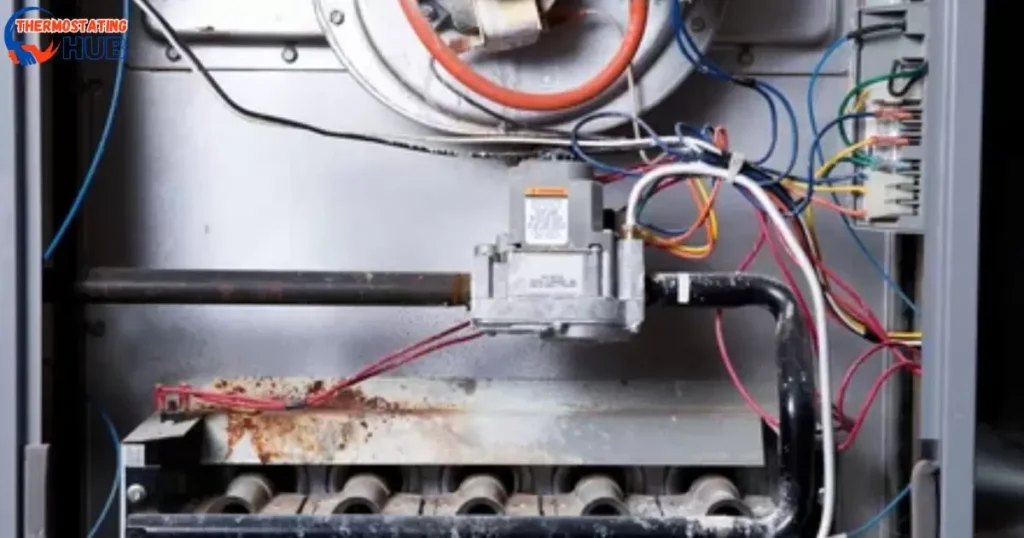
Looking ahead, the world of home heating is on the brink of exciting innovations to address furnace issues, especially the perplexing situation of a furnace running without blowing air.
As technology continues to advance, here’s a glimpse into some future possibilities:
1. Smart Diagnostics:
Imagine a furnace equipped with intelligent diagnostics that can self-assess and pinpoint issues. Smart sensors could analyze the performance of crucial components like the blower motor, blower wheel, and air filters. If any anomaly is detected, it could communicate directly with homeowners or HVAC professionals, offering insights into the problem.
2. Predictive Maintenance:
Future furnaces might embrace predictive maintenance models. By leveraging data analytics and machine learning, these systems could predict potential failures before they occur.
This proactive approach could involve automatic adjustments or notifications for timely maintenance, ensuring optimal performance and preventing issues like running without blowing air.
3. Integrated Airflow Management:
Imagine a furnace that heats and actively manages airflow throughout your home. Future systems could dynamically adjust airflow based on various factors such as occupancy, outdoor weather conditions, and individual room temperatures. This intelligent airflow management could address issues related to blocked vents or clogged filters, optimizing heating efficiency.
4. Remote Troubleshooting and Repairs:
In the future, homeowners might have access to remote troubleshooting and repair solutions. HVAC systems could be designed with the capability for remote diagnostics, allowing technicians to identify issues without a physical visit. This could lead to faster and more cost-effective resolutions for problems like a furnace running without blowing air.
5. Enhanced User Interfaces:
The future could bring more user-friendly interfaces for homeowners to interact with their heating systems. Touchscreen displays or mobile apps could provide real-time insights into the furnace’s performance, offering easy-to-understand notifications and suggestions for addressing issues promptly.
As we anticipate these innovations, it’s clear that the future of furnace technology holds promising solutions for addressing issues and ensuring seamless, efficient heating in our homes. 🌐
Blowing Air
| Pros | Cons |
| 1. Energy Efficiency: A running furnace without blowing air may still be using energy efficiently for heating. | 1. Lack of Heat Distribution: The main downside is the failure to distribute warm air throughout your home, resulting in uneven heating. |
| 2. Quiet Operation: The furnace operates quietly without the noise associated with blowing air. | 2. Potential Overheating: Continuous operation without air circulation may lead to overheating and damage to the furnace components. |
| 3. Maintains Temperature: The furnace can help maintain a baseline temperature in the immediate vicinity. | 3. Inefficient Heating: With proper air circulation, the heating process becomes more effective, leading to higher energy bills. |
While there might be a few perks to having a furnace running without blowing air, it’s essential to consider the drawbacks to guarantee efficient heating and avoid potential issues such as overheating or uneven warmth distribution.
If you find yourself in this situation, it’s wise to reach out to a professional HVAC technician. Their expertise can help diagnose and tackle the root cause, ensuring your furnace operates at its best. 👨🔧
Think of it like having a car engine that purrs but refuses to move—the potential is there, but it’s not fulfilling its purpose. Consulting with an HVAC technician is like having a mechanic for your furnace; they can pinpoint the issue and get everything back in working order so that you can enjoy the warmth without any hiccups.
Key Features to Troubleshoot a Furnace Running But Not Blowing Air

Focusing on key features is essential for efficient problem identification and resolution when troubleshooting a furnace running but not blowing air. Here are the key features to check:
1. Blower Motor Operation:
Start by examining the blower motor. Check if it’s spinning when there’s a demand for heat. A stationary blower may indicate a frozen motor, prompting the need for a manual spin or replacement.
2. Blower Wheel and Capacitor:
Assess the condition of the blower wheel and capacitor. If the wheel is not spinning freely, it may signal a problem. A malfunctioning capacitor could also hinder proper operation, necessitating cleaning or replacement.
3. Air Filters:
Examine the air filters for excessive clogging. Clogged filters can impede airflow, affecting the furnace’s ability to circulate air.
Regularly replace filters, especially if you have pets, to maintain optimal performance.
4. Ductwork:
Inspect the ductwork for any openings or dislocations. Broken ducts can lead to air escaping, hindering the efficient distribution of warmth. Seal off any leaks using duct tape or seek professional assistance for duct repairs.
5. Vent and Register Accessibility:
Ensure that air vents and registers are open and unobstructed. Blocked vents, whether by furniture or other objects, can disrupt the free flow of air. A clear path is crucial for effective warmth distribution.
6. Smart Thermostat Settings:
If your furnace is equipped with a smart thermostat, review the settings. Ensure the thermostat is programmed correctly, and check for any scheduling issues that might be affecting the furnace’s operation.
7. Safety Switch and Door Sensor:
Confirm that safety features like the door sensor are functioning correctly. The safety switch ensures that the blower operates only when the furnace door is securely closed. A malfunction in this area could lead to the blower not engaging.
8. Professional HVAC Consultation:
If all else fails or if you need more certainty about performing troubleshooting tasks, seek the expertise of a professional HVAC technician. They can conduct a comprehensive inspection, identify underlying issues, and provide accurate solutions.
Taking a systematic approach to these key features can significantly aid in troubleshooting a furnace that’s running but not blowing air, facilitating a more efficient and effective resolution.
Answers To Key Questions
Why is my furnace kicking on but no blower?
Possible reasons include a malfunctioning blower motor, a faulty relay switch, or issues with the thermostat. Professional inspection is recommended for accurate diagnosis and resolution.
Why is my blower running but no airflow?
This issue may be due to a clogged air filter, a malfunctioning blower motor, or problems with the ductwork. Regular maintenance, like checking the filter, and professional assistance can help identify and address the problem.
Why is my HVAC running but no air coming out?
Potential causes include a malfunctioning blower motor, a blocked air duct, or a faulty thermostat. It’s advisable to check these components and seek professional help for a comprehensive assessment.
What would cause a furnace blower not to kick on?
Causes may include a faulty blower motor, a malfunctioning capacitor, or issues with the thermostat. A professional inspection is recommended to determine the specific problem and carry out necessary repairs.
Final Thoughts
Troubleshooting a furnace running but not blowing air involves systematically checking key components like the blower motor, blower wheel, air filters, ductwork, vents, and thermostat settings. Regular maintenance is crucial for optimal performance.
Future innovations in HVAC technology promise exciting features such as smart diagnostics and predictive maintenance. For persistent issues, seeking professional HVAC consultation ensures accurate diagnosis and effective solutions. 🔍

I’m Matthew Porter, the HVAC enthusiast at thermostatinghub.com. Beyond being a writer, I’m your dedicated problem solver for all things heating and cooling. Join me on my blog for a storytelling adventure through the HVAC universe. Together, let’s transform your comfort challenges into tales of coziness!




